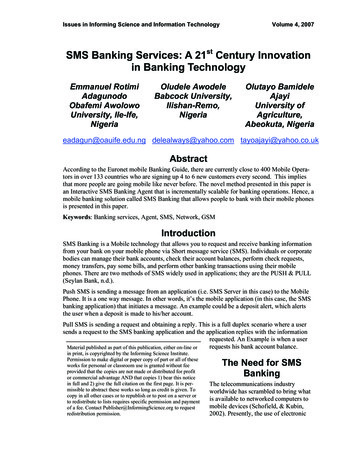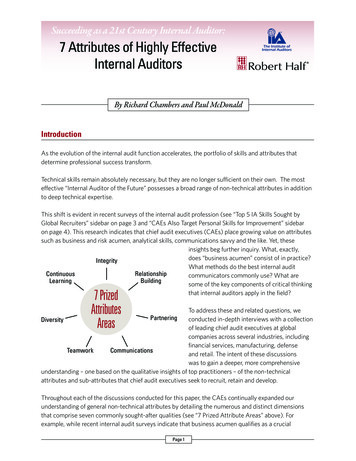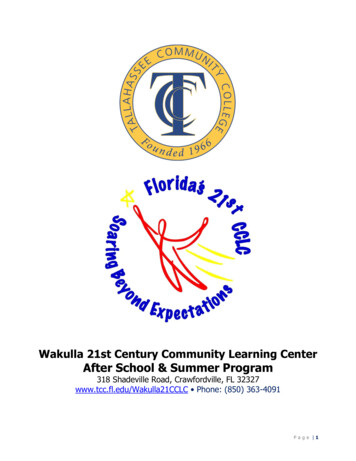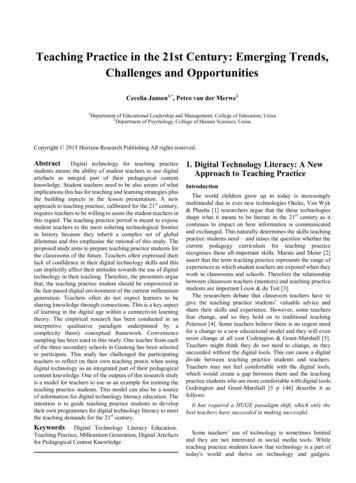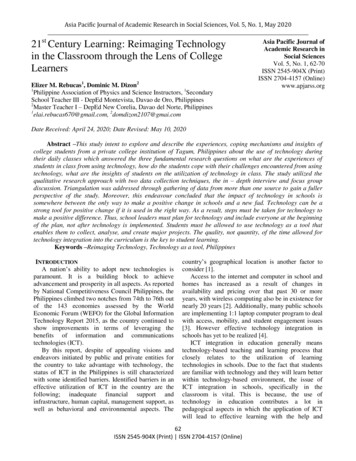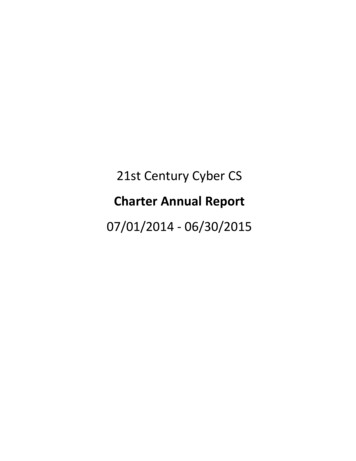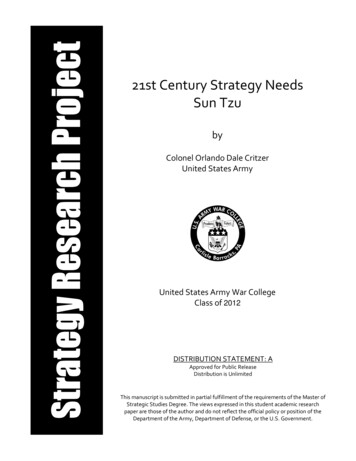
Transcription
21st Century Strategy NeedsSun TzubyColonel Orlando Dale CritzerUnited States ArmyUnited States Army War CollegeClass of 2012DISTRIBUTION STATEMENT: AApproved for Public ReleaseDistribution is UnlimitedThis manuscript is submitted in partial fulfillment of the requirements of the Master ofStrategic Studies Degree. The views expressed in this student academic researchpaper are those of the author and do not reflect the official policy or position of theDepartment of the Army, Department of Defense, or the U.S. Government.
The U.S. Army War College is accredited by the Commission on Higher Education of the Middle StatesAssociation of Colleges and Schools, 3624 Market Street, Philadelphia, PA 19104, (215) 662-5606. The Commissionon Higher Education is an institutional accrediting agency recognized by the U.S. Secretary of Education and theCouncil for Higher Education Accreditation.
Form ApprovedOMB No. 0704-0188REPORT DOCUMENTATION PAGEPublic reporting burden for this collection of information is estimated to average 1 hour per response, including the time for reviewing instructions, searching existing data sources, gathering and maintaining thedata needed, and completing and reviewing this collection of information. Send comments regarding this burden estimate or any other aspect of this collection of information, including suggestions for reducingthis burden to Department of Defense, Washington Headquarters Services, Directorate for Information Operations and Reports (0704-0188), 1215 Jefferson Davis Highway, Suite 1204, Arlington, VA 222024302. Respondents should be aware that notwithstanding any other provision of law, no person shall be subject to any penalty for failing to comply with a collection of information if it does not display a currentlyvalid OMB control number. PLEASE DO NOT RETURN YOUR FORM TO THE ABOVE ADDRESS.1. REPORT DATE (DD-MM-YYYY)2. REPORT TYPE22-03-2012Strategy Research Project3. DATES COVERED (From - To)4. TITLE AND SUBTITLE5a. CONTRACT NUMBER21st Century Strategy Needs Sun Tzu5b. GRANT NUMBER5c. PROGRAM ELEMENT NUMBER6. AUTHOR(S)5d. PROJECT NUMBERColonel Orlando Dale Critzer5e. TASK NUMBER5f. WORK UNIT NUMBER7. PERFORMING ORGANIZATION NAME(S) AND ADDRESS(ES)8. PERFORMING ORGANIZATION REPORTNUMBERAND ADDRESS(ES)Prof. Leonard J. Fullenkamp10. SPONSOR/MONITOR’S ACRONYM(S)9. SPONSORING / MONITORING AGENCY NAME(S) AND ADDRESS(ES)U.S. Army War College122 Forbes AvenueCarlisle, PA 1701311. SPONSOR/MONITOR’S REPORTNUMBER(S)12. DISTRIBUTION / AVAILABILITY STATEMENT122 Forbes AvenueDistribution A: Unlimited13.NOTES122SUPPLEMENTARYForbes AvenueCarlisle, PA 1701314. ABSTRACTToday’s world is filled with uncertainty and is a world where typical lines of the battlefield no longer exist. Thecurrent strategic environment remains best described as volatile, uncertain, complex, and ambiguous and is aworld where future contingencies involving the United States will be asymmetrical. As the current worldsuperpower, the United States will continue to find itself involved in world affairs whether we choose to or not andstrategists must be properly armed. Theories are useful tools that strategists need to carefully study andunderstand in order to effectively address both current and future strategic environments. Sun Tzu’s theoriesprovide military planners and strategists with a non-prescriptive approach to achieve success in modern warfareand demand careful examination before recommendations are made requiring the use of the Nation’s military tosenior leaders. This Strategic Research Paper will argue that several of the precepts of warfare addressed in SunTzu’s, The Art of War, remain relevant today, and that they will continue to, well beyond the twenty-first century.This paper will show that his precepts have influenced current doctrine and strategic decision-making through theuse of historic and more recent contingency operations.15. SUBJECT TERMSAsymmetrical, Avoidance, Intelligence, Deception, Leadership16. SECURITY CLASSIFICATION OF:17. LIMITATIONOF ABSTRACTa. REPORTb. ABSTRACTc. THIS PAGEUNCLASSIFEDUNCLASSIFEDUNCLASSIFED18. NUMBEROF PAGES19a. NAME OF RESPONSIBLE PERSON19b. TELEPHONE NUMBER (include areaUNLIMITED32code)Standard Form 298 (Rev. 8-98)Prescribed by ANSI Std. Z39.18
USAWC STRATEGY RESEARCH PROJECT21ST CENTURY STRATEGY NEEDS SUN TZUbyColonel Orlando Dale CritzerUnited States ArmyProfessor Leonard J. FullenkampProject AdviserThis SRP is submitted in partial fulfillment of the requirements of the Master of StrategicStudies Degree. The U.S. Army War College is accredited by the Commission onHigher Education of the Middle States Association of Colleges and Schools, 3624Market Street, Philadelphia, PA 19104, (215) 662-5606. The Commission on HigherEducation is an institutional accrediting agency recognized by the U.S. Secretary ofEducation and the Council for Higher Education Accreditation.The views expressed in this student academic research paper are those of the authorand do not reflect the official policy or position of the Department of the Army,Department of Defense, or the U.S. Government.U.S. Army War CollegeCARLISLE BARRACKS, PENNSYLVANIA 17013
ABSTRACTAUTHOR:Colonel Orlando Dale CritzerTITLE:21st Century Strategy Needs Sun TzuFORMAT:Strategy Research ProjectDATE:22 March 2012KEY TERMS:Asymmetrical, Avoidance, Intelligence, Deception, LeadershipWORD COUNT: 6,670PAGES: 32CLASSIFICATION: UnclassifiedToday’s world is filled with uncertainty and is a world where typical lines of thebattlefield no longer exist. The current strategic environment remains best described asvolatile, uncertain, complex, and ambiguous and is a world where future contingenciesinvolving the United States will be asymmetrical. As the current world superpower, theUnited States will continue to find itself involved in world affairs whether we choose to ornot and strategists must be properly armed. Theories are useful tools that strategistsneed to carefully study and understand in order to effectively address both current andfuture strategic environments. Sun Tzu’s theories provide military planners andstrategists with a non-prescriptive approach to achieve success in modern warfare anddemand careful examination before recommendations are made requiring the use of theNation’s military to senior leaders. This Strategic Research Paper will argue that severalof the precepts of warfare addressed in Sun Tzu’s, The Art of War, remain relevanttoday, and that they will continue to, well beyond the twenty-first century. This paper willshow that his precepts have influenced current doctrine and strategic decision-makingthrough the use of historic and more recent contingency operations.
21ST CENTURY STRATEGY NEEDS SUN TZUThe art of war is of vital importance to the state. It is a matter of life anddeath, a road to safety or ruin. Therefore, it is a subject that must bestudied thoroughly.Sun TzuThe Art of War1This paper will focus on Sun Tzu whose precepts of warfare have affected, andwill continue to affect, strategic decision-making today and beyond the twenty-firstcentury. Sun Tzu’s theories, as well as the theories of numerous other theorists, have atremendous impact on warfare. His writings provide numerous ways to think throughboth complex and simple issues and provide advice on problem solving regarding warsand employment of military power. His principles provide military planners andstrategists with a non-prescriptive approach to achieve success in warfare. Thoughthere are many insights provided by Sun Tzu, this paper will focus primarily on histheories surrounding the importance of strategy, intelligence, deception, strategicleadership, and most importantly, achieving victory. This paper will attempt to show howsome of these insights have become common language in our doctrine and will providenumerous examples of operations where commanders and strategists havesuccessfully applied the insights to achieve victory.Today’s world is filled with uncertainty and is a world where the typical lines ofthe battlefield no longer exist. We live in a world where terrorism continues to grow andgain strength across the global environment, in a world where irregular warfare iscommon practice, and in a world where the balance of power does not appear to exist.The United States, along with its allies, are challenged globally by numerous
adversaries driven by ideology, religious beliefs, wealth imbalances, resourceshortages, and unlimited desires for control. According to General George W. Casey,the previous Army Chief of Staff, “the Army must be prepared to deal with a full“spectrum” of potential conflicts. For the future not only holds the danger of terrorismand the rise of failed states, but also struggles to gain control of diminishing resources—energy, food, water—made more acute by a new status quo.”2 General Caseyrecognized the need for a persistent campaign against extremist organizations like alQaeda and others. All these drivers, coupled with other factors, have lead to the currentstrategic environment that is filled with uncertainty. Both current and futureenvironments will increasingly require use of the Nation’s military, coupled with allelements of national power to successfully address this uncertainty.Unstable conditions have lead to increased numbers of rogue states and terroristorganizations who are willing to use any level of violence to achieve their political andideological ends. They will continue to present tremendous challenges that will affectour role as the only modern-day superpower. In the words of a prominent nationalsecurity professional, Mark McNeilly, “The United States faces many potentialadversaries, both in the form of nation states and terrorist organizations. Each day, astechnology progresses, the ability of these adversaries to inflict harm on U.S. militaryunits, national infrastructure, or civilians increases.”3 In the 2010 National SecurityStrategy, President Obama also addressed this concern stating “moreover, as we facemultiple threats—from nations, non-state actors, and failed states—we will maintain themilitary superiority that has secured our country, and underpinned global security, fordecades.”42
The world we confront requires a properly resourced and fully capable militarywith exceptional leadership, coupled with well-educated strategic planners at all levelswithin our government. Both military leaders and strategic planners, civilian and military,need to understand the strategic concepts found amongst both modern and historicaltheorists, most specifically, the tactical concepts found in the writings of Sun Tzu, whichremain relevant in today’s asymmetrical environment. As the former Chairman of theJoint Chiefs of Staff Colin Powell said, “I’ve read the Chinese classic The Art of Warwritten by Sun Tzu. Sun Tzu has been studied for hundreds of years. He continues togive inspiration to soldiers and politicians. So every American soldier in the Army knowsof his works. We require our soldiers to read it.”5 Sun Tzu’s theories can be applied totoday’s environment and have been supported by leaders at all levels including thosewho wage war and those who have the responsibility to make the decisions aboutengaging in war.As the current world superpower, the United States will continue to find itselfinvolved in world affairs whether we choose to or not. The odds are high that theopposition we may potentially encounter will not challenge us directly with large-scaleconventional warfare. Instead, the opposition will most likely challenge us indirectly andthat requires an indirect approach to be applied. Sun Tzu understood this hundreds ofyears ago and his writings reflect so by stating, “He who knows the art of the direct andthe indirect approach will be victorious.”6 He provides numerous tactical insights thatcan be applied from the operational to the strategic level and these insights arenecessary tools to deal with both the current and the future world of uncertainty.3
Sun Tzu the Master StrategistThe exact dates of Sun Tzu’s birth and his death are unknown, but he livedaround 500 B.C.7 The name Sun Tzu (“Master Sun”) is an honorific title bestowed uponSun Wu, the author of the Sun Tzu Ping Fa (The Art of War). According to Chinesetradition, he was a member of the “Shi (intellect) during the consolidation of the Springand Autumn Period (represented an era in Chinese History between 722 BC and 481BC).8 Sun Tzu’s classic, The Art of War is the first known study of the planning andconduct of military operations. In the foreword of Samuel Griffith’s, Sun Tzu, The Art ofWar, B.H. Liddell Hart, the great British strategist and thinker described Sun Tzu as themost concentrated essence of wisdom on the conduct of war, and only Clausewitz iscomparable; but as theory observed, “the clarity of Sun Tzu’s thought could havecorrected the obscurity of Clausewitz.”9 Hart continues on stating, “among all the militarythinkers of the past . . . Sun Tzu has clearer vision, more profound insight, and externalfreshness.”10Some military historians suggest that Napoleon applied Sun Tzu’s philosophiesin his military planning and one, Robert Cantrell, even suggested that he carried a copyof Sun Tzu’s book with him on his campaigns.11 While some historian’s debate if andwhen a man named Sun Tzu actually existed, the great early Chinese historiographerSsu-ma Ch’ien states that Sun Tzu was born in the state of Ch’i. Ssu-ma Ch’ien furtherstates that he became a general for the King of Wu during the aforementioned Springand Autumn period in China (722-481 B.C.) and won great victories for him. To handdown the wisdom he gained from his years in battle and his observations of statecraft,Sun Tzu wrote The Art of War. The book has given guidance to military theorists and4
generals throughout time. The Art of War became popular among not only militaryleaders but among leaders of the state. Cantrell went on so far as to say, “Sun Tzu’sideas cover not only warfare but state craft; not only military strategy but grandstrategy.”12 Indeed, it is not too much to say that the principles found within the text ofSun Tzu’s book have been used successfully in countless battles and crises throughouttime, ranging from the battles of Gettysburg; to the Cuban Missile Crisis; to OperationDesert Storm; to the operations in both Iraq and Afghanistan.Whether the knowledge found in Sun Tzu’s, The Art of War stems from thecreativity of a single mind or from the collective genius of several, matters little. Whatendures is the clarity of thought, the precision of expression, the proven value of thecollected observation as applied to countless examples down through history. Accordingto Mark McNeilly, “what we can all be sure of is that a book known as The Art of Warmost certainly exists and that the lessons it has to teach strategists, are as deep andmeaningful today as they were two thousand years ago.”13Current and Projected Strategic EnvironmentIn the parlance of the United States Army War College, the current strategicenvironment can best be described as volatile, uncertain, complex, and ambiguous(VUCA), with the future environment appearing to share the same characteristics, andpotentially at an even greater degree. Though the United States remains the preeminentpower of the world, an increasing number of state and non-state actors continue toexhibit consequential influence. This change in the distribution of power indicates amovement towards a “multi-nodal” world characterized more by shifting, interest-drivencoalitions based on diplomatic, military, and economic power, than by rigid security5
competition between opposing blocs. Both global and regional powers are exhibitingnationalism and assertiveness that tests our partner’s resilience and United Statesleadership.14In the foreseeable future, the United States should continue to remain theforemost economic and military power though that position will continuously bechallenged. The ability of the United States to maintain its position of economic andmilitary power could be greatly affected given the enormity of the current and projectednational debt.15 New challenges will continue to surface and the world will continue toface many of the same challenges it faces today. The world population will continue togrow and become increasingly urbanized, driving the demand for already scarceresources even higher. The desire for nuclear weapons and the potential forproliferation of them by terrorists, rogue nations, and non-state actors will continue togrow.There is growing concern as non-state actors such as criminal organizations,traffickers, and terrorist groups are working vigorously to exploit global commons byacquiring technologies to advance their interest in attempts to challenge our ability toproject power from global commons. Non-state actors are using available technology tocoordinate and operate globally to spread their extremist ideologies and attack theUnited States. These are only a few of the multitude of challenges the world willconfront with the potential for armed conflict remaining an ever-serious challenge. Thestrategic environment today, and in the future, cannot simply be addressed with militarypower alone. Military power coupled with the Nation’s other instruments of statecraft willcontinue to be absolutely necessary.166
During his “Landon Lecture” at Kansas State University on 26 November 2007,then Secretary of Defense Robert Gates stated “We can expect that asymmetricwarfare will be the mainstay of the contemporary battlefield for some time. Theseconflicts will be fundamentally political in nature, and require the application of allelements of national power. Success will be less a matter of imposing one’s will andmore a function of shaping behavior—of friends, adversaries, and most importantly, thepeople in between.”17 According to Alan Stephens and Anita Baker, “many interventionsin civil conflicts, failing states, and humanitarian crises, have been characterized by, andconsequently suffered from, the absence of strategy.” 18 Sun Tzu understood this needand addressed it accordingly through the strategy he revealed in his writings.Significance of Theory—Sun Tzu’s StrategySun Tzu provides basic tools for strategist at all levels to address thecomplexities threaded throughout today’s world of uncertainty and in one whereconventional and indirect warfare tactics and techniques are required. Specifically, hebrings awareness to the significance of strategy as it applies to waging war, to theconcept of battle avoidance, and to the need for both military and diplomaticinvolvement to achieve victory. He provides a very flexible approach to address thecomplexities surrounding the current strategic environment that involves uncertainty,terrorism, and both irregular and asymmetrical warfare. To understand the messagesembedded in his writings, several terms should be clearly understood to include,strategy, terrorism, irregular warfare. Strategy as defined in JP 1-02, is “the art andscience of developing and employing instruments of national power in a synchronizedand integrated fashion to achieve theater, national and/or multi-national objectives.”197
Terrorism as defined in JP 1-02, is “the calculated use of unlawful violence or threat ofunlawful violence to inculcate fear; intended to coerce or to intimidate governments orsocieties in the pursuit of goals that are generally political, religious, or ideological.”20Irregular Warfare as defined in Air Force Doctrine Document 2-3, Irregular Warfare, is,“a violent struggle among state and non-state actors for legitimacy and influence overthe relevant population(s). Irregular warfare favors indirect and asymmetric approaches,though it may employ the full range of military and other capacities, in order to erode anadversary's power, influence, and will.”21 A close reading of The Art of War shows thatSun Tzu anticipated these definitions and further, that his theory provides practicalinsights, strategies, and tactics that leaders and strategist have applied in pastencounters, and can apply to problems in the current and future strategic environment.What Sun Tzu understood thousands of years ago, and articulated in his writing, TheArt of War, has become common spoken language and its meanings and interpretationsare threaded throughout the language of our current military doctrine.Key Tenets of Sun TzuStrategy. Sun Tzu was extremely prudent as far as strategy was concerned. Heconsidered it best to subdue the enemy’s army without fighting and pointed out, “To winone hundred victories in one hundred battles is not the acme of skill. To subdue theenemy without fighting is the supreme excellence.”22 He reveals his thoughts on thesignificance of strategy with the admonition that “War is a matter of vital importance tothe State: the province of life or death; the road to survival or ruin. It is mandatory that itbe thoroughly studied.”23 Sun Tzu further states that, “Victory is the main object inwar.”24 War must be studied and those involved with war planning must develop clearly8
defined strategies to achieve success. “The supreme excellence in war is to attack theenemy’s plan; next best to disrupt his alliances; next best to attack his army’ the worst isto attack his cities.”25But, Sun Tzu did not advocate going directly to war. He understood theseriousness of war and believed that rational men had the capacity with their moral andintellectual faculties to make the right decisions.26 More importantly, he believed thatwar was a last resort and that battle avoidance techniques including frustration of theenemy, the use of spies to gain information, the sowing of dissension, and the nurturingof subversion were key parts of the strategy to win.Sun Tzu devoted considerable time and attention to concerns prior to theengaging in war to include the significance of diplomatic engagement strategies asalternatives to achieve stated objectives.27 He expressed great awareness of the direconsequences resulting from decisions to engage in war and that diplomacy was thebest means to achieve success without engaging in bloodshed as a result of fighting.He identified dire consequences that included the potential for significant draining ofresources that included populations and cities. Sun Tzu believed that every possiblemeans to avoid war should be investigated first. “Only when the enemy could not beovercome by these means was there recourse to armed force, which was to be appliedso that victory was gained:(a) in the shortest possible time(b) at the least possible cost of lives and effort(c) with infliction on the enemy of the fewest possible casualties.”289
He understood and supported battle avoidance and believed those involved withthe design or execution of strategy should fully understand this concept. “Thus, thoseskilled in war subdue the enemy's army without battle.They capture his cities withoutassaulting them and overthrow his state without protracted operations.”29 There are twoways this can be achieved. One is through the use of political, economic, psychological,and moral means before engaging in military efforts, and the other is through the use ofa wise war strategy when military means are put into play. Wise war strategy means notjust seeking to fight battles, but utilizing intelligence, deception, surprise, speed, andother methods to either outmaneuver the enemy or to ensure that any battles will end invictory.As a result, the goal of strategy is not only to achieve the nation's aims throughcontrolling or influencing its sphere of influence, but to do so without resorting tofighting.30 Sun Tzu, in The Art of War, identified and codified many operationalpractices that are regarded as maxims for all types of conflicts today. He providedguidance on deception, when to advance and when to withdraw, when to attack andwhen to defend, the disposition of forces, discipline, and intelligence. Throughout thebook, Sun Tzu stresses the significance of both the political and psychological aspectsof conflict and he provides numerous observations regarding the character of war aswell as the multitude of issues that a true strategist should consider when determininghow to achieve victory. According to Stephens and Baker, “strategists contemplating theends-ways-means construct at any intensity of conflict could not wish for moreilluminating wisdom.”31 In the Washington Post, General (Retired) Wesley Clark cautionsagainst the simple and sole application of military force to contemporary conflict issues,10
advising never go to war unless you can describe and create a more desirable end state. . . and doing so requires a whole lot more than just the use of force. He concludesAmericans must understand that the goal of war is to achieve a specific purpose for thenation. In this respect the military is simply a tool of statecraft, one that must work intandem with diplomacy, economic suasion, intelligence and other instruments of UnitedStates power.32Intelligence. Intelligence as defined in JP 3-0, Joint Operations, is “intelligenceidentifies enemy capabilities, helps identify enemy and friendly centers of gravity(COGs), projects enemy courses of action (COAs), and assists in planning friendly forceemployment. The process also attempts to identify what the enemy is able to discernabout friendly forces.”33 Intelligence can also be defined as “processed, accurateinformation, presented in sufficient time to enable a decision-maker to take whateveraction is required. Poor intelligence can be attributed several factors: the lack ofintelligence funding or skills; limited methods available to obtain, conduct analysis, orthe dissemination of intelligence; the inability of leadership to understand which is mostimportant; or the belief by political leadership the intelligence gathering is unfair orunethical.34 Sun Tzu repeatedly emphasizes the significance and advantages ofintelligence and drives the issue home with his focus on knowing the enemy. Headdresses why we must use all the tools available to us including imagination andinnovation to be victorious.His attitude towards the significance of intelligence could not be more clearlystated than in his words “Know your enemy and know yourself: in a hundred battles youwill never be in peril. When you are ignorant of the enemy but know yourself, your11
chances of winning or losing are equal. If ignorant of both your enemy and of yourself,you are certain in every battle to be in peril.”35 Belief that we can shape ourcircumstances implies ownership of a thorough and sophisticated understanding of theoperating environment. Central to any understanding is access to credible intelligence—or in Sun Tzu’s words, foreknowledge. According to Sun Tzu, “what is calledforeknowledge cannot be elicited from spirits, not from gods, nor by analogy with pastevents, nor from calculations. It must be obtained from men who know the enemysituation.”36According to Stephens and Baker, decision makers need knowledge aboutourselves, our enemies—and knowledge of our friends. It is not something as simple asprojecting the future based on events of the past. Though opponents may not alwaysknow each other’s intentions, they can at least understand each other’s capabilities.37Good leaders will know their enemy’s strengths and weaknesses, their preferredbehavior, and how susceptible they are to deception. Most of this knowledge can onlybe achieved through human agents who know personally the enemy leaders they aredealing with. Sun Tzu drives the importance of this home by stating “secret operationsare essential in war: upon them the army relies to make every move.”38According to Army General Peter Cuviello, for many years the Army hadextremely limited capabilities to collect, record, store, process, and disseminateinformation, that is, in Sun Tzu-like terms, to know the enemy and know ourselves.39Commanders lacked clear situational awareness and the ability to communicate intentto subordinate leaders, which has a direct impact on a commander’s ability to effectivelyoperate. Technology is enabling us to be a transformed, network-centric military that12
operates in three domains—the physical domain, the information domain, and theknowledge domain. In the all-important battle for information superiority on today’sbattlefield, the information domain is undoubtedly the most important domain to leadersat all levels.According to John Garstka, the assistant director for Concepts and Operations atthe DOD Office for Force Transformation, “Our soldiers and equipment operate in thephysical domain. The information they need is created, manipulated and shared in theinformational domain. But, to succeed in network-centric warfare, we must transform ouroperations into the knowledge domain, where our force has the capability to developand share high-quality situational awareness.”40 The knowledge domain is where ourmilitary has the capability to develop a shared knowledge of commander’s intent and iswhere we have the capability to self-synchronize operations. What this means simply isthat we are on the cusp of succeeding with Sun Tzu’s vision to fully know our enemiesand to know ourselves. Army General Peter Cuviello concludes with observation, “weuse this knowledge so that we truly need not fear a hundred battles, so that we can winthis war on terrorism, and so we can transform our Army to meet any challenge it facesin the 21st Century.”41One of the more dramatic illustrations of the connection between intelligence andstrategic shaping is evident in the confrontation between the USSR and the UnitedStates during the Cold War. In this example, ignorance on the part of one protagonist ofthe other’s capabilities might precipitate a pre-emptive nuclear strike, as a result of theunfounded fear resulting from the consequences of i
21ST CENTURY STRATEGY NEEDS SUN TZU The art of war is of vital importance to the state. It is a matter of life and death, a road to safety or ruin. Therefore, it is a subject that must be studied thoroughly. Sun Tzu The Art of War1 This paper will focus on Sun
